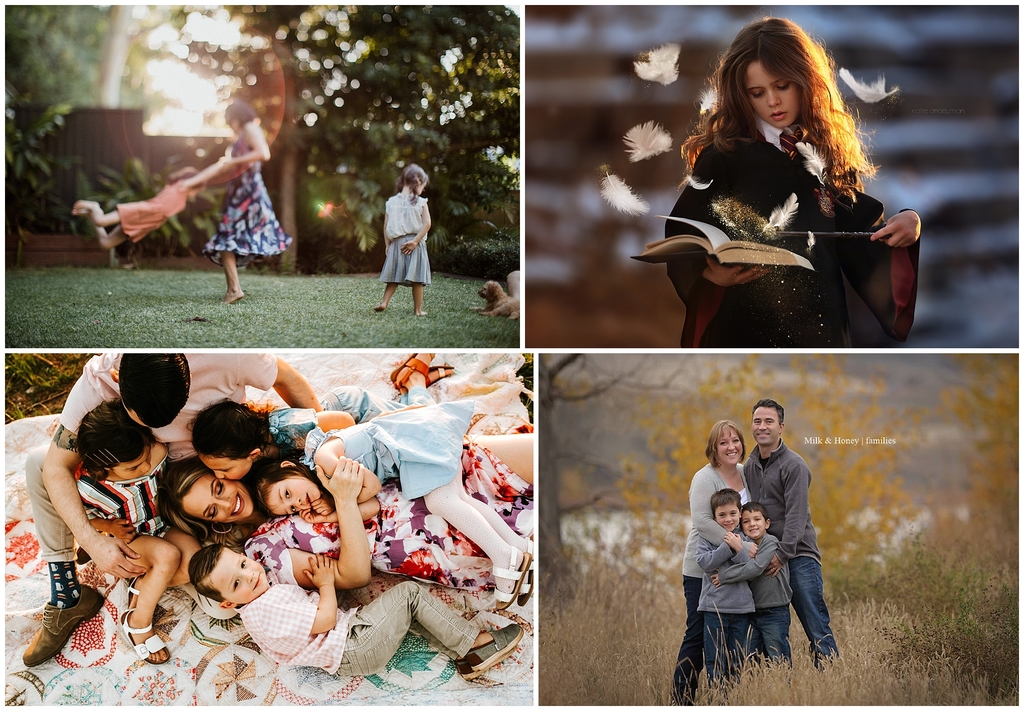Getting Started with Family Photography

When you are just getting started with family photography, it is important to visualize the entire process from start to finish – each aspect has the power to make or break the overall outcome.
Maybe you’re an experienced newborn photographer whose clients now grow up and want family photos. Or maybe you’re brand new to photography and family photography really speaks to you. Let’s have a look at things you should consider.
Your style and portfolio
The first step in getting started with family photography is to decide on your style. Do you like traditional posed images? Or does more candid lifestyle shoots appeal to you? Maybe you’re an emotive photographer who chooses to focus on emotional connections. Or a fine art photographer that like to use editing to transform images into something magical.

Images: Courtney Holmes Films, Katie Andelman Photography,
Mal Jack Photography, Milk & Honey Photography
Deciding who you are (and being consistent in that style) is super important to ensure happy clients. Your portfolio needs to show what you want to sell. Your clients will be hiring you because they identify with what you show in your portfolio, so make sure what you show on your website and in social media is consistent with your chosen style, and that you are able (and willing!) to replicate that style.
How do you know what your style is? The best way to know is to do! Your Pinterest feed may be filled with stunning documentary family images, but you may dread the thought of not ever directing a family! Just because you love seeing a style, doesn’t mean you will love doing that style.
Do a few model calls, focus on just one style per shoot, and analyze your results afterwards. How did you feel while shooting? Did anything feel forced? Do the resulting images resonate with you? Does a particular session make your heart beat out of your chest with excitement (that’s a good sign!).
To help you figure out your style, we’ve compiled a style quiz for you. It only takes a couple of minutes to complete! Take the quiz here!
The pre-session consultation
I already mentioned that managing your client expectations is essential. While the first step in doing that is a clearly defined style, equally important is knowing what your clients want/need from a session, and making sure those needs are met.
Hence, a pre-session consultation. And one of the easiest ways to do that is by having your clients fill out a questionnaire with carefully designed questions before their session.
These questions should touch on client contact details, establish the family dynamics (kids’ ages, interests, fears), the family’s experience with family photos and why they want them, how they intend using their photos, and any must-haves in terms of location, poses, etc.

Image: Penguin Pictures
It could be done in person before the session, or you could simply send them a pdf to complete. There are also applications you can use for them to fill out the questionnaire online.
Need more ideas? Download our handy Family Session Questionnaire Guide here.

Client contracts
Don’t ever think “I’m just starting out, I don’t need a contract.” In fact, when you’re inexperienced, you probably need a contract even more!
A contract protects both you and your client, and clearly states the roles and responsibilities of each party. It establishes timelines, addresses situations like cancellations and reshoots, and states what is included in the session (and what isn’t).
The most reliable source for contracts online is The Law Tog. The amazing Rachel Brenke is both a lawyer and a photographer and has created a collection of legal tools and documents specifically designed for photographers.
Once you have your basic contract, it is imperative to have your own lawyer look it over and adjust it as needed to reflect your local legislation.
Equipment
Don’t make the mistake of thinking that getting started with family photography means that you need a top of the range camera and a lens for every occasion before you can get going!
You simply need equipment that suits your style. For your camera body, consider the amount of light that you would typically have available. If you are shooting in good outside light, a cropped sensor camera would be fine. But when you are doing lifestyle sessions in low light indoors, you will have to look at a full frame camera with better performance at high ISO.
Your lens choice will depend on your shooting style as well. Some photographers love being close to their clients and interacting and capturing little details – the 24-70mm, 35mm prime and 50mm prime lenses are all great candidates! The best way to make a choice is to rent some lenses before you make a choice on which one to invest in.

Image: Hailey Faria Photography
If you prefer being more of a fly on the wall, longer lenses like a 135mm or the 70-200mm lens would be amazing.

Image: Milk & Honey Photography
And if none of those are in your budget, you can absolutely make your kit lens work. Just shoot with the widest aperture so you can create some creamy bokeh.
Location
For outdoor sessions, it is very likely that a client will look to you to suggest a location for the session. So make sure that you have 2 or 3 locations ready that you know would work for the type of session they would like.
For a photographer, location scouting doesn’t ever stop, as you will find yourself evaluating every field or forest or clearing you see as you drive around in your city! That is how you find your magical spots that make your work look unique in the long run.
But when you’re just getting started with family photography, don’t hesitate to simply ask in your local photographer Facebook groups which locations are popular – you should get plenty of feedback.
What makes a good location for a traditional outdoor family session?
- Open shade – you generally want to pose your families in a shady spot, but looking out towards a bright open sky. That way the sunlight isn’t hitting them directly, but there is still enough light on their faces.
- Trees – as the sun dips behind the treeline, the trees break up the light enough to create backlight that is soft enough to create those beautiful golden, hazy and warm images families love.
- Variety – it is a bonus if your location has different elements (paths, fields, water, logs, etc.) that will provide variety in your gallery, rather than just different poses in the same spot.

Image: Stormy Solis Photography
Timing
Shooting in full sun is extremely challenging and not something you want to do when you’re just starting out. Instead, opt for shooting in golden hour – that magical hour right after sunrise, and right before sunset, when the sun is low in the sky and likely to be diffused by trees or buildings, and creates a warm glow in your images.

In the summer, sunset can be pretty late, and result in sessions that may run after young children’s bedtime. I always give my clients the option of shooting in the morning, or letting them know that it’s just one day of having to adjust their schedules – an extra afternoon nap that day can be all that is needed!
Posing
“What do you want us to do?”
How to pose your clients is usually the number one concern for family photographers, now matter how experienced your are. And you will have to pose clients, even if you are a lifestyle photographer.
Having a posing plan is essential. Consider all the different pairings and make sure you have some ideas for all the essential poses: whole family, just the kids, each kid individually, just parents, and each parent with kids. We have tons of ideas for you in these blog posts:
- Sitting Poses for Families
- Standing Poses for Families
- Mom and Child Poses
- Dad and Child Poses
- Sibling Poses
In my sessions, I usually start with a formal, everyone looking at the camera type of shot for each pose. From there, I encourage interaction through different prompts, and shoot the more candid moments that ensue.

So what do you say to your families to get those real smiles and connection? We’ve got you covered with more than 50 ideas in our free Keeping it Real Guide!
Editing
Most photographers use Adobe Lightroom and/or Photoshop for editing (you can have access to both with a subscription to Creative Cloud for Photographers). Of the two, Lightroom is generally the easier to use when you’re new to photography. But it does have limitations in terms of functionality – for heavy editing like doing headswaps and altering elements in the photo, you will have to dive into Photoshop.
A word of warning about presets and actions. You may be tempted to purchase these in the beginning, thinking that they will make your photos look just like the photos of the photographers selling them. Unfortunately, this is not the case – the final look all depends on the shooting style, lighting conditions and camera settings of the original photo.
As long as you can be realistic about your expectations, presets and actions can be a great time-saver. Just realize there are no “one-click solutions” – you will always have to make tweaks to the editing depending on your specific photo.

Image Delivery
Consider that once you have completed a session and done the editing, you need to find a way to deliver the images to your client. If you offer prints, you need to find a reliable professional photo lab to fulfill your orders. Most labs offer test prints you can order from which you can gauge color accuracy and quality.
You will also have to decide how to deliver digital copies of the images. Physical options include CD and USB drives, but consider that many computers don’t have optical drives to load CDs anymore. USBs are still popular right now, but you have to expect that one day it will go the same way as the floppy disc!
There are also many online gallery delivery platforms, all with different features. Currently, Shootproof and Pixieset are popular options. Most have trial period where you can try the service for free.
Education
There is no better time to invest in your education than when you are just getting started with family photography. Every year, we bring together some of the best family photographers in the industry, and ask them to pour their hearts out into sharing all they know with our students.
The online Family Retreat is your chance to learn from the best, in the comfort of your own home, with no travel involved. Posing, business, marketing, editing, connection … it’s all covered! Check it out now!
related
Posts

I'm
Lisa DiGeso
I’m on a mission to create uplifting online experiences for photographers ready to elevate their art, their business and their mindset.(...and have fun along the way!)







































